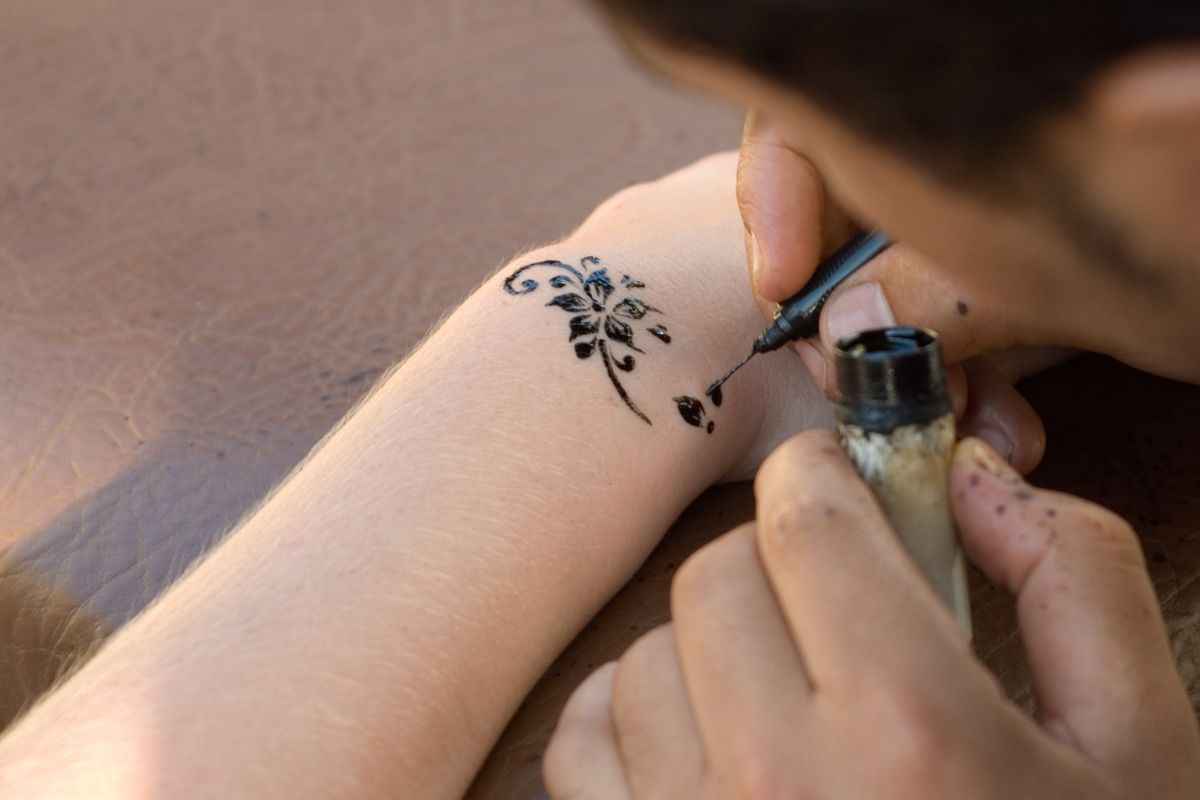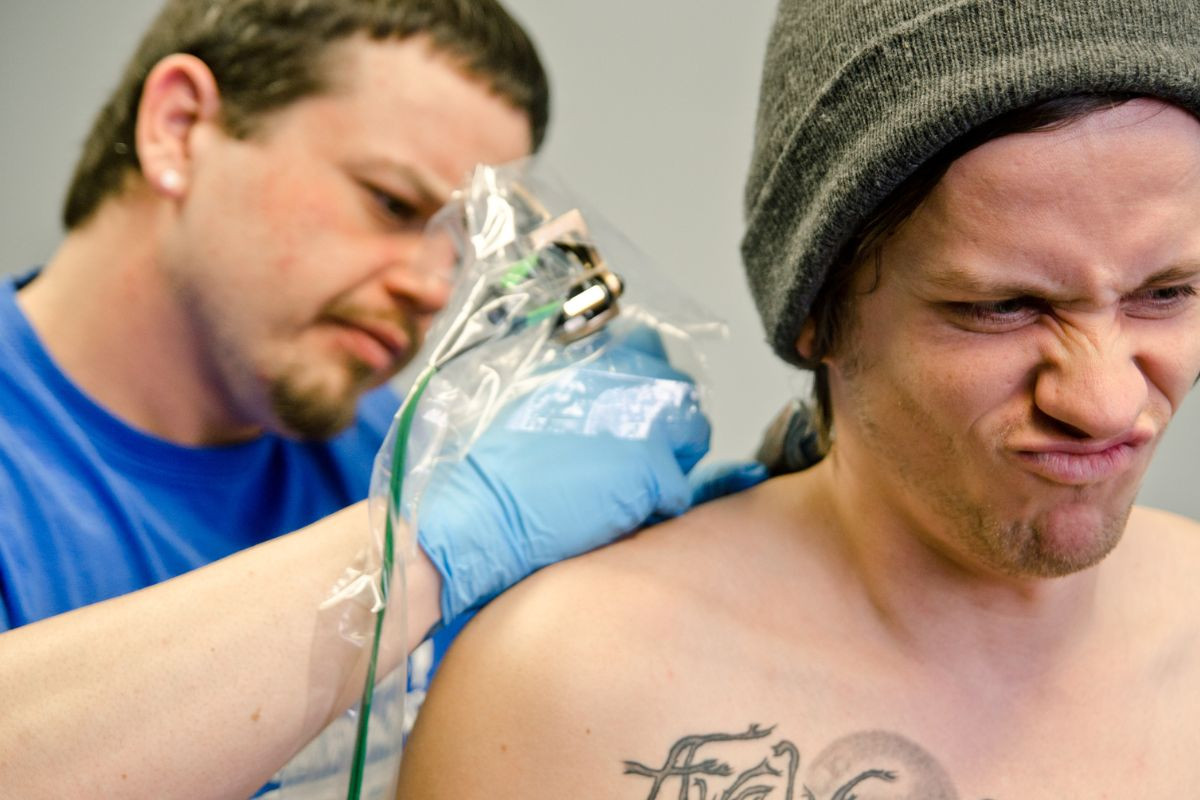Temporary tattoos offer a fantastic way to experiment with body art without the lifelong commitment. How Long Does A Temporary Tattoo Last? At tattooat.com, we understand the appeal of temporary body art and offer insights into maximizing its lifespan. This guide explores various types of temporary tattoos, factors influencing their longevity, and tips for keeping them looking vibrant. Discover everything you need to know about temporary tattoo duration, application, and maintenance.
1. Understanding the Lifespan of Temporary Tattoos
Temporary tattoos typically last from 3 to 7 days, but this can vary considerably. The longevity of your temporary tattoo depends on factors such as the type of tattoo, skin preparation, and aftercare. Custom temporary tattoos, especially those from high-quality sources, often outlast generic versions.
Here’s a breakdown of typical lifespans for different types of temporary tattoos:
- Traditional Stick-On Tattoos: 2-5 days
- Airbrush Tattoos: 5-10 days
- Henna Tattoos: 1-3 weeks
- Jagua Tattoos: 1-2 weeks
- Custom Temporary Tattoos: Up to 2 weeks
2. Key Considerations Before Getting a Temporary Tattoo
Before applying a temporary tattoo, consider your skin type and lifestyle. Oily skin may cause tattoos to fade quicker, while dry skin tends to hold them longer. Activities that involve water exposure, such as swimming, can also reduce a tattoo’s lifespan.
 Woman showing off her shoulder with a custom temporary tattoo, highlighting the design's detail and placement.
Woman showing off her shoulder with a custom temporary tattoo, highlighting the design's detail and placement.
2.1. Best Body Placements for Longevity
Choosing the right location on your body can significantly affect how long your temporary tattoo lasts.
- Long-Lasting Spots (7+ days):
- Upper arm (outer area)
- Chest
- Back
- Thigh (outer area)
- Calf
- Quick-Fading Spots to Avoid:
- Hands and feet
- Neck
- Joints (elbows, knees)
- Areas with frequent friction
3. Maximizing Your Temporary Tattoo’s Lifespan
To get the most out of your temporary tattoo, proper preparation and maintenance are essential. Here are steps to prepare your skin and care for your design:
3.1. Before Application
- Exfoliate the Area: Remove dead skin cells to create a smooth surface.
- Clean the Skin: Use soap and water to remove oils and dirt.
- Dry Completely: Ensure the skin is fully dry before application.
- Avoid Lotions and Oils: These can interfere with the adhesive.
3.2. After Application
- Dry Completely: Allow the tattoo to dry fully after application.
- Setting Spray/Baby Powder: Apply a light layer to help set the tattoo.
- Avoid Excessive Washing: Limit washing or scrubbing the area.
- Minimize Water Exposure: Reduce time in water, especially swimming pools.
4. Types of Temporary Tattoos and Their Lifespan
Different types of temporary tattoos offer varying lifespans and application methods. Understanding these differences helps you choose the best option for your needs.
| Type of Temporary Tattoo | Description | Lifespan | Key Factors Affecting Longevity |
|---|---|---|---|
| Standard Water-Transfer | Common tattoos applied with water and a damp cloth. | 3–7 days | Friction, water exposure, and skin type. |
| Henna Tattoos | Natural dye from the henna plant, develops color over hours. | 1–3 weeks | Skin preparation, type of henna, and aftercare. |
| Jagua Tattoos | Made using jagua fruit-based ink. | 1–2 weeks | Skin type, ink quality, and aftercare. |
| Airbrush Tattoos | Stencils and body-safe paint applied using airbrush machines. | 2–7 days | Exposure to water, friction, and activity level. |
| Sticker Tattoos | Pre-printed designs that stick to the skin. | 1–3 days | Moisture, friction, and surface preparation. |
| Metallic Tattoos | Shiny, decorative tattoos for special occasions. | 3–6 days | Skin type, sweat, and product quality. |
| Temporary Ink Tattoos | Ink sits on the skin without penetrating. | 1–2 weeks | Ink formula, skin type, and exposure to external factors. |
| UV/Glow Tattoos | Tattoos glow under UV light, made with special inks. | 1–2 days | Exposure to water and physical activity. |
| Custom Temporary Tattoos | Personalized designs for events or branding, available at tattooat.com. | 3–7 days | Quality of materials and skin preparation. |
| Spray-On Tattoos | Temporary tattoos sprayed onto skin using templates. | 1–3 days | Skin type, moisture levels, and physical activity. |
4.1. Stick-on Temporary Tattoos
- Lifespan: 2-5 days
- Application: Water and pressure
- Best For: Parties, festivals, kids’ events
- Cost: $1-5 per tattoo
4.2. Henna Tattoos
- Lifespan: 1-3 weeks
- Application: 1-2 hours to apply, 24 hours to develop
- Best For: Special occasions, cultural events
- Color Options: Brown, reddish-brown only
- Cost: $20-50 per design
4.3. Jagua Tattoos
- Lifespan: 10-14 days
- Application: Similar to henna
- Best For: Dark blue/black temporary designs
- Cost: $30-60 per design
4.4. Airbrush Temporary Tattoos
- Lifespan: 5-10 days
- Application: Professional application needed
- Best For: Large designs, gradient effects
- Cost: $50-100+ depending on size
5. Why Choose Temporary Over Permanent?
Temporary tattoos offer numerous advantages, making them an attractive choice for many. They allow risk-free experimentation with different designs, making them perfect for special events, parties, and testing out ideas before committing to permanent ink. Application is pain-free and significantly more affordable than permanent tattoos.
 An artist meticulously applying a custom temporary tattoo to a person's hand, showcasing precision and artistry.
An artist meticulously applying a custom temporary tattoo to a person's hand, showcasing precision and artistry.
6. Making Your Temporary Tattoo Last Longer
Proper preparation and care can significantly extend the life of your temporary tattoo. Clean, exfoliated skin provides the best canvas for application. After applying, let it dry completely before engaging in activities.
For optimal results:
- Avoid applying lotions or oils before application.
- Keep the area dry for at least 1 hour after application.
- Pat dry, don’t rub, after showers.
- Apply a light dusting of baby powder to protect the design.
7. Daily Activities and Your Temporary Tattoo
Daily activities can impact the lifespan of your temporary tattoo. Understanding these impacts and how to minimize them is crucial for longevity.
| Activity | Impact on Temporary Tattoo | How to Minimize Harm |
|---|---|---|
| Frequent Showering | Weakens adhesive bonds and accelerates fading. | Use lukewarm water and pat dry gently. Avoid scrubbing the tattoo. |
| Swimming | Chlorine and saltwater degrade adhesive and pigments. | Apply waterproof barrier cream before swimming. |
| Exercise and Sweating | Sweat dissolves adhesives and fades colors. | Wear moisture-wicking clothing and avoid touching the tattoo area. |
| Use of Oil-Based Products | Oils dissolve adhesives, causing the tattoo to peel off. | Avoid applying oils or lotions near the tattoo. |
| Exposure to Sunlight | UV rays break down pigments and fade colors. | Apply sunscreen over the tattoo to protect it. |
| Friction from Clothing | Constant rubbing weakens adhesive and damages design. | Choose loose-fitting clothing that doesn’t touch the tattoo area. |
| Sleeping Position | Direct pressure or rubbing against bedding can fade tattoo. | Sleep on your back or side to avoid contact with the tattoo. |
| Hot Water Exposure | Hot water dissolves adhesive layers quickly. | Limit exposure to hot baths and showers. |
| Touching or Scratching | Physical contact can peel off or damage the tattoo design. | Avoid unnecessary touching and keep the area clean. |
| Using Harsh Soaps | Chemicals in harsh soaps can erode the adhesive. | Opt for mild, fragrance-free soaps when cleaning. |
Pro Tip: Applying a setting spray or a thin layer of petroleum jelly can help protect your tattoo during daily activities.
7.1. Swimming & Bathing
- Pool Swimming:
- Wait 24 hours after application before swimming.
- Chlorine reduces tattoo life by 40-50%.
- Limit pool time to 30 minutes if possible.
- Apply waterproof sunscreen over the tattoo.
- Beach & Ocean:
- Saltwater fades tattoos faster than freshwater.
- Limit exposure to 1-2 hours maximum.
- Reapply sunscreen every hour.
- Rinse with fresh water after ocean swimming.
7.2. Exercise & Sports
 A woman doing exercises while wearing a temporary tattoo, potentially affecting its lifespan due to sweat and friction.
A woman doing exercises while wearing a temporary tattoo, potentially affecting its lifespan due to sweat and friction.
- Gym Workouts:
- Apply tattoo 24 hours before heavy exercise.
- Wear moisture-wicking clothes over the tattoo.
- Pat dry immediately after sweating.
- Avoid direct contact with exercise equipment.
- Outdoor Activities:
- Apply sunscreen over the tattoo (SPF 30+).
- Wear breathable clothing for protection.
- Avoid excessive sweating in the first 24 hours.
- Keep the area clean and dry when possible.
7.3. Clothing & Daily Wear
- What to Avoid:
- Tight elastic bands or waistbands
- Rough fabrics like denim directly over the tattoo
- Synthetic materials that don’t breathe
- Shoulder straps or bra straps rubbing the design
- Best Practices:
- Choose loose, cotton clothing
- Avoid scratching or rubbing the area
- Let skin breathe when possible
- Change clothes if they become sweaty
8. Why Choose Temporary Over Permanent?
Choosing between temporary and permanent tattoos depends on your lifestyle, preferences, and commitment level. Temporary tattoos offer flexibility, affordability, and zero pain, while permanent tattoos provide a lasting form of self-expression.
| Aspect | Temporary Tattoos | Permanent Tattoos |
|---|---|---|
| Cost | Affordable, typically under $10 per design. | Expensive, ranging from $100 to several thousand dollars. |
| Pain Level | Completely painless to apply. | Can be very painful depending on placement and size. |
| Durability | Lasts 3–7 days, depending on care and type. | Lasts a lifetime; requires laser removal to erase. |
| Design Flexibility | Easy to change or experiment with different designs. | Difficult and costly to modify or remove once inked. |
| Health Risks | Minimal risks; uses FDA-approved or natural materials. | Potential risks of infection, allergic reactions, or scarring. |
| Application Process | Simple, quick, and requires no professional assistance. | Requires professional tattoo artists and sterile environments. |
| Skin Impact | Sits on the surface of the skin; no penetration involved. | Penetrates the skin’s dermis layer, permanently altering it. |
| Commitment | Ideal for temporary events or personal expression. | Permanent and requires a lifetime commitment. |
| Removal Process | Fades naturally or can be removed easily with water or oils. | Painful, expensive, and may leave scars after laser removal. |
| Customization | Easy to create custom designs for specific events or branding. | Customization possible but costly and time-intensive. |
8.1. Perfect for Life’s Special Moments
Temporary tattoos are ideal for weddings, celebrations, and events where you want to showcase a unique and temporary design.
- Matching bride tribe designs
- Wedding date tattoos
- Anniversary celebrations
- Custom birthday designs
8.2. Try Before You Commit
Experiment with designs, sizes, and placements before deciding on a permanent tattoo.
- See how the design looks on your skin tone
- Test different sizes and placements
- Live with the design for a week
- Get feedback from friends and family
8.3. Cost & Pain Benefits
Enjoy the look of a tattoo without the high cost and pain of permanent ink.
 A person wincing in pain while receiving a permanent tattoo, contrasting with the painless application of temporary tattoos.
A person wincing in pain while receiving a permanent tattoo, contrasting with the painless application of temporary tattoos.
- Permanent tattoos: $150-$500+ per hour
- Temporary tattoos: $5-$50 per design
- No touch-up costs
- Change designs whenever you want
8.4. Practical Advantages
Temporary tattoos are perfect for conservative workplaces where permanent tattoos may not be appropriate.
- Perfect for conservative workplaces
- Remove for important meetings
- Change designs based on dress code
- No career-limiting concerns
8.5. Creative Freedom
Express yourself with endless design possibilities without the commitment.
- Switch designs with your mood
- Match your outfit or occasion
- Try bold designs without commitment
- Experiment with different styles
With temporary tattoos from tattooat.com, you gain the creative expression of body art without the permanence, pain, or expense of traditional tattoos.
9. Conclusion
Temporary tattoos offer a fantastic way to express yourself without the permanent commitment. Understanding how long a temporary tattoo lasts and following proper care instructions will help you enjoy your temporary art to the fullest. Whether it’s for a special occasion or simply to try something new, temporary tattoos are a versatile and fun option.
Visit tattooat.com for a wide selection of temporary tattoo designs and expert advice on application and care. Explore your creativity and express yourself with confidence! Located at 1825 SW Broadway, Portland, OR 97201, United States, or call us at +1 (503) 725-3000.
10. FAQs
10.1. Can I create my own custom temporary tattoos?
Yes, you can! Many services offer custom temporary tattoos, allowing you to create personalized designs.
10.2. What is the history of temporary tattoos?
Temporary tattoos have a rich history, evolving from ancient body art to modern-day accessories.
10.3. How long do temporary tattoos last?
Temporary tattoos typically last between 2 to 14 days, depending on various factors.
10.4. How do temporary tattoos work?
Temporary tattoos adhere to the skin through a transfer process using water or special adhesives.
10.5. Are there any benefits to using temporary tattoos?
Yes! Temporary tattoos offer creative self-expression, branding opportunities, and even medical uses.
10.6. How can I apply a temporary tattoo properly?
Applying a temporary tattoo correctly involves a few simple techniques for a flawless result.
10.7. Can I make temporary tattoos last longer?
Yes, proper aftercare and avoiding excessive friction can increase durability.
10.8. Are temporary tattoos safe for all skin types?
Most temporary tattoos are skin-safe, but it’s important to check ingredients if you have sensitive skin.
10.9. Where can I buy high-quality temporary tattoos?
High-quality temporary tattoos can be found at specialty retailers and online stores like tattooat.com.
10.10. What should I do if a temporary tattoo causes skin irritation?
If irritation occurs, remove the tattoo immediately and clean the area with mild soap and water. Consult a dermatologist if irritation persists.